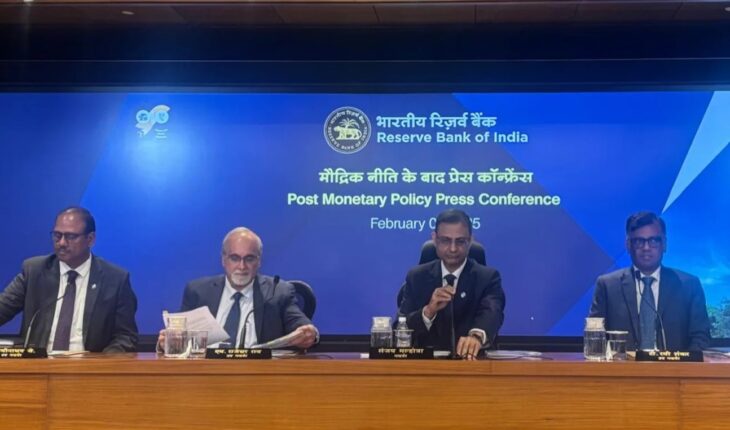The Reserve Bank of India has cut the repo rate by 0.25 percent in the monetary review done on February 7, bringing it down from 6.50 percent to 6.25 percent. It is worth noting that the repo rate has been cut after about 5 years.
The central bank was refraining from cutting the repo rate till now mainly due to inflation. At present, there is instability in the market due to changes in global policies, such as tariff, protectionism, the stance of the Federal Reserve Bank of US in terms of policy interest rates, etc. Also, in view of the slow pace of GDP in the last two quarters, it is necessary for the government to promote development.
Therefore, in the budget too, emphasis has been laid on increasing investment, savings and consumption, because only by accelerating these, economic activities can be accelerated, and development can be accelerated.
It is worth noting that the National Statistical Office (NSO) has projected the GDP growth rate to be 6.4 percent in its first advance estimate for the Gross Domestic Product (GDP) for the financial year 2024-25, which is lower than the last 3 financial years. During the last financial year, the GDP growth rate was 8.2 percent. At the same time, the Reserve Bank of India has projected the GDP to grow at the rate of 6.6 percent during the financial year 2024-25.
Earlier, the GDP growth rate during the financial year 2020-21 was minus 6.60 percent. Thereafter, the GDP growth rate during the financial year 2021-22, financial year 2022-23 and financial year 2023-24 was 8.70 percent, 7.2 percent and 8.2 percent respectively, while in the first quarter of the financial year 2024-25, it was 6.7 percent and in the second quarter it was 5.4 percent.
Retail inflation has come down to 5.22 percent in December, which is the lowest level in 4 months. Earlier in November, the inflation rate was at 5.48 percent. Food items contribute about 50 percent to the inflation basket. Their inflation has come down from 9.04 percent to 8.39 percent on a month-on-month basis, while rural inflation has come down from 5.95 percent to 5.76 percent and urban inflation has come down from 4.89 percent to 4.58 percent.
It is worth noting that last month the Reserve Bank of India had raised the inflation forecast for the financial year 2024-25 to 4.8 percent, while earlier the central bank had projected it to be at the level of 4.5 percent. However, inflation is expected to remain within the tolerance limit set by the Reserve Bank of India in FY 2025 and FY 2026.
Inflation plays an important role in determining one’s purchasing power. When inflation increases, the prices of both goods and services increase, which reduces the purchasing power of the person and reduces the demand for goods and services. Then, their sales decrease, their production decreases, the company suffers losses, workers are laid off, employment generation decreases, etc. As a result, economic activities slow down, and the pace of development is hampered. In such a situation, it would be appropriate to say that only by reducing inflation can the vehicle of development move forward at a fast pace.
If we compare the Indian economy with the growth rate of the global economy, then our economy is much above the global level. According to the Organization for Economic Cooperation and Development (OECD), the global GDP growth rate was 3.2 percent in 2024 and can be 3.3 percent in 2025, whereas, according to the IMF, the global economy can grow at the rate of 3.1 percent in 2024 and 3.2 percent in 2025.
In the second quarter of the current financial year, China’s GDP growth rate was 4.6 percent, while in Japan this growth rate was 0.9 percent. According to the IMF, the growth rate in England is estimated to be 1.1 percent in the financial year 2024 and 1.5 percent in the financial year 2025, whereas the growth rate in Germany is estimated to be minus 0.1 percent in the financial year 2024 and 0.7 percent in the financial year 2025.
The Indian economy is in a better position than the world’s most powerful country, US, and it is expected to remain strong in the coming years as well. The growth rate in US is estimated to be 2.7 percent during the financial year 2024 and 2.0 percent in the financial year 2025.
After having loan growth between 14 percent to 16 percent in the last two years, the overall credit growth has been slowing down for the last few months and in December 2024 it has come down to 11.2 percent. A major reason for this is the high lending rate.
Banks do not have cheap capital. Therefore, they are forced to lend at expensive rates and due to the availability of loans at expensive rates, common people and businessmen are avoiding taking loans. Because of this, companies are short of capital, due to which they are not able to produce at full capacity.
By cutting the repo rate by 0.25 percent by the Reserve Bank of India, banks will get capital at a cheaper rate and they will be able to lend at a cheaper rate and when loans are available at a cheaper rate, both common people and businessmen will take loans, which will accelerate both investment and savings and consumption will growth as well as economic activities will also upsurge.
In such a situation, it would be appropriate to say that it was necessary to cut the repo rate to accelerate economic activities. However, inflation is also within the tolerance limit and a decline has been recorded in the month of December.
In the budget, the government has clearly stated that its aim is to accelerate development. However, despite the decline in GDP growth rate in two quarters, the Indian economy remains strong, and India’s growth rate is higher than even developed countries. Despite this, the government wants that it is necessary to accelerate the growth rate to make India a developed country by the year 2047. To achieve this goal, the GDP growth rate should be at least 8 to 9 percent.
Satish Singh, Ahmedabad Based Senior Columnist, views are personal.






